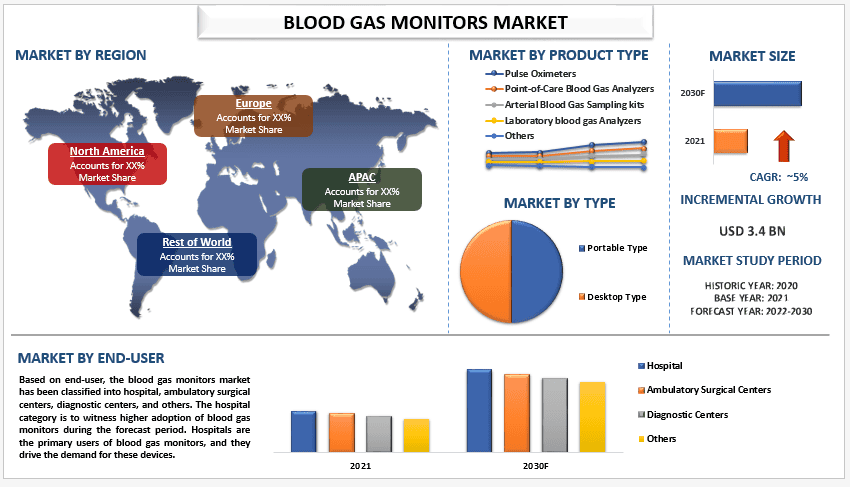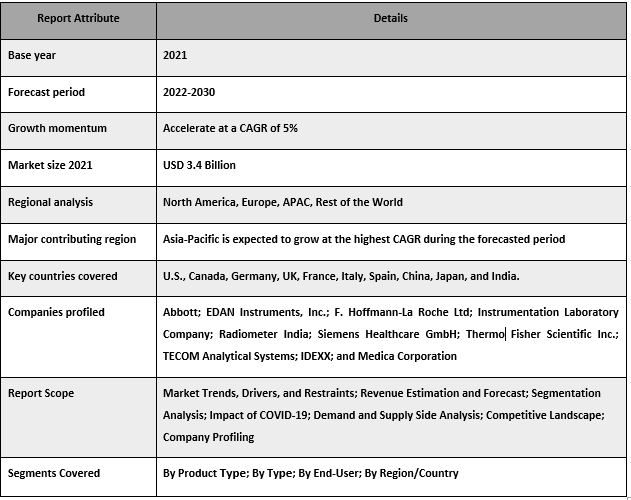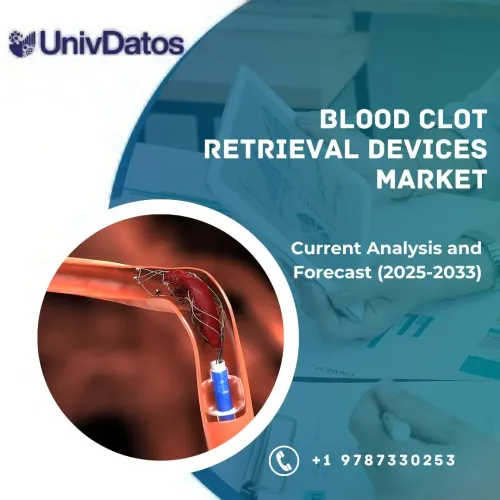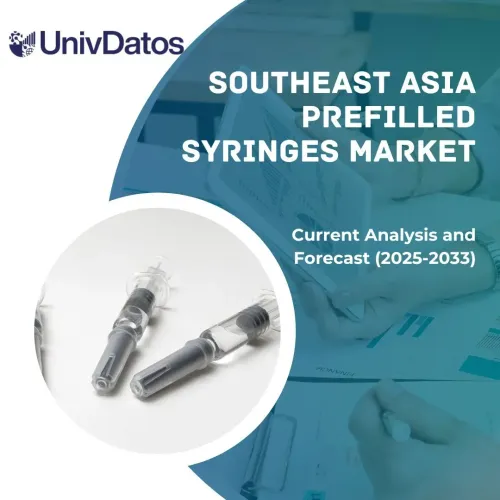Рынок мониторов газов крови: текущий анализ и прогноз (2022-2030)
Упор на тип продукции (пульсоксиметры, анализаторы газов крови для диагностики на месте оказания медицинской помощи, наборы для забора артериальной крови, лабораторные анализаторы газов крови и прочее); тип (портативный и настольный); конечный пользователь (больницы, амбулаторные хирургические центры, диагностические центры и прочее); и регион/страна

Объем рынка мониторов газов крови в 2021 году оценивался в 3,4 миллиарда долларов США и, как ожидается, будет расти с высокими среднегодовыми темпами роста (CAGR) около 5% в течение прогнозируемого периода (2022-2030 гг.). Это в основном связано с развитием технологий и разработкой инновационных систем мониторинга газов крови. Производители представляют портативные портативные устройства и системы тестирования по месту оказания медицинской помощи (POCT), которые обеспечивают удобство, простоту использования и более быстрые результаты. Эти технологические достижения облегчают мониторинг у постели больного, сокращают время выполнения и улучшают уход за пациентами в различных медицинских учреждениях, включая машины скорой помощи, отделения интенсивной терапии и клиники. Более того, рынок мониторов газов крови обусловлен несколькими факторами, такими как растущая распространенность респираторных заболеваний, таких как хроническая обструктивная болезнь легких (ХОБЛ) и астма. Эти состояния требуют непрерывного мониторинга параметров газов крови для оценки тяжести дыхательной недостаточности и разработки соответствующих стратегий лечения. Например, по данным Всемирной организации здравоохранения (ВОЗ), по оценкам, в 2019 году астмой страдали 262 миллиона человек, и она стала причиной 455 000 смертей. Кроме того, растущее глобальное гериатрическое население, восприимчивое к респираторным заболеваниям и сопутствующим заболеваниям, еще больше стимулирует спрос на мониторы газов крови.
Некоторые из основных игроков, работающих на рынке, включают Abbott; EDAN Instruments, Inc.; F. Hoffmann-La Roche Ltd; Instrumentation Laboratory Company; Radiometer India; Siemens Healthcare GmbH; Thermo Fisher Scientific Inc.; TECOM Analytical Systems; IDEXX; и Medica Corporation. Этими игроками было предпринято несколько слияний и поглощений наряду с партнерскими отношениями, чтобы предоставлять клиентам высокотехнологичные и инновационные продукты/технологии.
Аналитические выводы, представленные в отчете
«Среди типов продукции категория лабораторных анализаторов газов крови занимала значительную долю рынка в 2021 году»
На основе типа продукта рынок сегментирован на пульсоксиметры, анализаторы газов крови по месту оказания медицинской помощи, наборы для забора артериальной крови, лабораторные анализаторы газов крови и другие. Среди них категория лабораторных анализаторов газов крови занимала значительную долю рынка в 2021 году. Это в основном связано с растущей распространенностью респираторных и метаболических расстройств, а также с растущим спросом на тестирование по месту оказания медицинской помощи. Ожидается, что разработка новых и усовершенствованных лабораторных анализаторов газов крови, таких как анализаторы, предлагающие мониторинг в режиме реального времени и беспроводное соединение, также будет стимулировать рост рынка мониторов газов крови.
«Среди конечных пользователей больничный сегмент занимал большую часть рынка в 2021 году»
На основе конечного пользователя рынок мониторов газов крови был классифицирован на больницы, амбулаторные хирургические центры, диагностические центры и другие. Ожидается, что в течение прогнозируемого периода в больницах будет наблюдаться более широкое внедрение мониторов газов крови. Больницам требуются мониторы газов крови для измерения уровней pH, кислорода и углекислого газа в крови. Мониторы газов крови необходимы для диагностики и мониторинга респираторных и метаболических расстройств, таких как хроническая обструктивная болезнь легких (ХОБЛ), астма и почечная недостаточность. По мере увеличения спроса на диагностические услуги увеличивается и спрос на мониторы газов крови.
«Ожидается, что Европа будет расти с самым высоким среднегодовым темпом роста (CAGR) в течение прогнозируемого периода»
Ожидается, что Европа будет расти с самым высоким среднегодовым темпом роста (CAGR) в течение прогнозируемого периода. Рынок в Европе характеризуется строгими нормативными рамками и стандартами, обеспечивающими безопасность, точность и качество мониторов газов крови. Кроме того, страны Европы уделяют особое внимание предоставлению качественных медицинских услуг, и мониторы газов крови играют жизненно важную роль в оптимизации ухода за пациентами. Больницы, диагностические лаборатории и клиники являются ключевыми конечными пользователями в регионе. Кроме того, высокая распространенность респираторных заболеваний, таких как хронический бронхит и синдром дыхательной недостаточности, способствует спросу на мониторы газов крови. Например, в сентябре 2021 года, согласно Европейскому респираторному журналу, по оценкам, к концу 2050 года 49 453 852 человека будут страдать ХОБЛ с распространенностью 9,3%.
Обзор отчета о рынке мониторов газов крови

Причины купить этот отчет:
- Исследование включает анализ размера рынка и прогнозирование, подтвержденные проверенными ключевыми экспертами отрасли.
- Отчет представляет собой краткий обзор общих показателей отрасли с первого взгляда.
- Отчет охватывает углубленный анализ видных представителей отрасли с уделением особого внимания ключевым финансовым показателям бизнеса, портфелям продуктов, стратегиям расширения и последним разработкам.
- Подробное изучение движущих сил, ограничений, ключевых тенденций и возможностей, преобладающих в отрасли.
- Исследование всесторонне охватывает рынок по различным сегментам.
- Углубленный анализ отрасли на региональном уровне.
Варианты настройки:
Глобальный рынок мониторов газов крови может быть дополнительно настроен в соответствии с требованиями или любым другим сегментом рынка. Кроме того, UMI понимает, что у вас могут быть свои собственные бизнес-потребности, поэтому не стесняйтесь обращаться к нам, чтобы получить отчет, который полностью соответствует вашим требованиям.
Содержание
Методология исследования для анализа рынка мониторов газов крови (2022-2030 гг.)
Анализ исторического рынка, оценка текущего рынка и прогнозирование будущего рынка глобального рынка мониторов газов крови были тремя основными этапами, предпринятыми для создания и анализа внедрения умных домов в основных регионах мира. Было проведено тщательное вторичное исследование для сбора исторических данных о рынке и оценки текущего размера рынка. Во-вторых, для подтверждения этих выводов были приняты во внимание многочисленные результаты и предположения. Кроме того, были проведены исчерпывающие первичные интервью с отраслевыми экспертами по всей цепочке создания стоимости глобального рынка мониторов газов крови. После предположения и подтверждения рыночных данных посредством первичных интервью мы использовали восходящий/нисходящий подход для прогнозирования общего размера рынка. После этого были приняты методы разбивки рынка и триангуляции данных для оценки и анализа размера рынка сегментов и подсегментов отрасли. Подробная методология описана ниже:
Анализ исторического размера рынка
Этап 1: Углубленное изучение вторичных источников:
Было проведено подробное вторичное исследование для получения исторических данных о размере рынка мониторов газов крови из внутренних источников компании, таких как годовые отчеты и финансовая отчетность, презентации результатов деятельности, пресс-релизы и т. д., и внешних источников, включая журналы, новости и статьи, правительственные публикации, публикации конкурентов, отраслевые отчеты, базы данных третьих сторон и другие надежные публикации.
Этап 2: Сегментация рынка:
После получения исторических данных о размере рынка мониторов газов крови мы провели подробный вторичный анализ для сбора исторических данных о рынке и доле различных сегментов и подсегментов для основных регионов. Основные сегменты, включенные в отчет, включают тип продукта, тип и конечного пользователя. Далее был проведен анализ на уровне стран для оценки общего внедрения моделей тестирования в этом регионе.
Этап 3: Факторный анализ:
После получения исторических данных о размере рынка различных сегментов и подсегментов мы провели подробный факторный анализ для оценки текущего размера рынка мониторов газов крови. Кроме того, мы провели факторный анализ с использованием зависимых и независимых переменных, таких как тип продукта, тип и конечный пользователь рынка мониторов газов крови. Был проведен тщательный анализ сценариев спроса и предложения с учетом ведущих партнерств, слияний и поглощений, расширения бизнеса и запуска продуктов в секторе рынка мониторов газов крови по всему миру.
Оценка и прогноз текущего размера рынка
Оценка текущего размера рынка: Основываясь на действенных выводах, полученных на основе вышеуказанных 3 этапов, мы пришли к текущему размеру рынка, ключевым игрокам на глобальном рынке мониторов газов крови и долям рынка сегментов. Все необходимые процентные доли и разбивки рынка были определены с использованием вышеупомянутого вторичного подхода и проверены посредством первичных интервью.
Оценка и прогнозирование: Для оценки и прогнозирования рынка различным факторам, включая движущие силы и тенденции, ограничения и возможности, доступные для заинтересованных сторон, были присвоены веса. После анализа этих факторов были применены соответствующие методы прогнозирования, то есть восходящий/нисходящий подход, для получения рыночного прогноза на 2030 год для различных сегментов и подсегментов на основных рынках мира. Методология исследования, принятая для оценки размера рынка, включает в себя:
- Размер рынка отрасли в денежном выражении (доллары США) и темпы внедрения рынка мониторов газов крови на основных рынках внутри страны.
- Все процентные доли, разбивки и разбивки сегментов и подсегментов рынка
- Ключевые игроки на мировом рынке мониторов газов крови с точки зрения предлагаемой продукции. Кроме того, стратегии роста, принятые этими игроками для конкуренции на быстрорастущем рынке.
Подтверждение размера и доли рынка
Первичное исследование: Были проведены углубленные интервью с ключевыми лидерами мнений (KOL), включая руководителей высшего звена (CXO/VP, руководители отдела продаж, руководители отдела маркетинга, руководители операционного отдела, руководители региональных отделов, руководители стран и т. д.) в основных регионах. Затем были обобщены результаты первичного исследования и проведен статистический анализ для доказательства заявленной гипотезы. Данные, полученные в результате первичного исследования, были объединены с результатами вторичного исследования, что превратило информацию в действенные выводы.
Разделение первичных участников по различным регионам

Инжиниринг рынка
Метод триангуляции данных был использован для завершения общей оценки рынка и получения точных статистических данных для каждого сегмента и подсегмента глобального рынка мониторов газов крови. Данные были разделены на несколько сегментов и подсегментов после изучения различных параметров и тенденций в областях типа продукта, типа и конечного пользователя на глобальном рынке мониторов газов крови.
Основная цель исследования глобального рынка мониторов газов крови
В исследовании были точно определены текущие и будущие рыночные тенденции глобального рынка мониторов газов крови. Инвесторы могут получить стратегические идеи, чтобы основывать свое усмотрение для инвестиций на качественном и количественном анализе, выполненном в исследовании. Текущие и будущие рыночные тенденции определили общую привлекательность рынка на региональном уровне, предоставив промышленному участнику платформу для использования неиспользованного рынка, чтобы воспользоваться преимуществом первопроходца. Другие количественные цели исследований включают:
- Анализ текущего и прогнозного размера рынка мониторов газов крови в стоимостном выражении (доллары США). Также проанализируйте текущий и прогнозный размер рынка различных сегментов и подсегментов
- Сегменты в исследовании включают области типа продукта, типа и конечного пользователя
- Определение и анализ нормативно-правовой базы для индустрии умных домов
- Анализ цепочки создания стоимости с участием различных посредников, а также анализ поведения клиентов и конкурентов в отрасли
- Анализ текущего и прогнозного размера рынка мониторов газов крови для основного региона
- Основные страны регионов, изученные в отчете, включают Азиатско-Тихоокеанский регион, Европу, Северную Америку и остальной мир
- Профили компаний рынка мониторов газов крови и стратегии роста, принятые участниками рынка для поддержания устойчивости на быстрорастущем рынке.
- Углубленный анализ отрасли на региональном уровне
Связанные Отчеты
Клиенты, купившие этот товар, также купили










